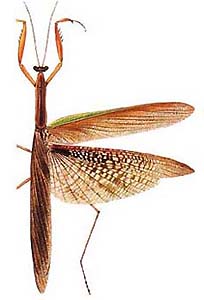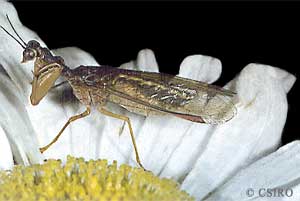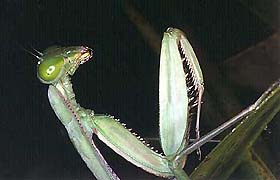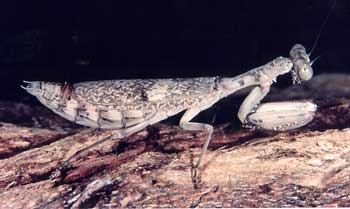|
Mantodea:
praying mantids
Characteristics
Praying
mantids are often easily recognised due to their large size, which
can range from 10 to 120 millimetres in body length and their characteristic
way of standing with forelegs held together as if they were praying.
All praying mantids have the following features:
|

Tenodera australasiae (purple-winged mantid)
|
|
- Raptorial
front legs with one or two rows of spines
- 2 pairs of
wings, both of which are used in flight. Although some species
have reduced wings and others are wingless
- Forewings
protectively hardened to cover the membranous
hind wings when at rest
- Very mobile
triangular shaped head with distinctive ocelli
The males of
most species are fully winged while many females have either reduced
wings or no wings at all. The nymphs
of praying mantids look like small adults but lack wings or have
developing wing buds.
Some species
of Neuroptera
in the family Mantispidae, like the one pictured below can be mistaken
for praying mantids as they also have raptorial
front legs, however further examination reveals they do not have
the hardened forewings present in Mantodea.
|

Mantispidae
species
|
Life Cycle
Mating
in praying mantids is direct and in some species the female may
attack and eat the male during or after mating. The female lays
her eggs in a foamy substance that hardens into a distinctive case.
Most people would have seen these cases attached to branches, tree
trunks, logs and even paling fences and houses. This egg case known
as an ootheca
may contain up to 400 eggs depending on the species. Some female
mantids stay with the eggs until they hatch while others leave as
soon as the eggs are laid. The nymphs
hatch resembling small adults and develop through a series of stages,
moulting several times before reaching maturity. In cooler areas
nymphs
may take up to one year to reach maturity but in warmer climates
there may be up to 2 generations in one year.
 |
Feeding
Praying
mantids are carnivorous
as both adults and nymphs
and eat a wide variety of insects, which they seize with their powerful
forelegs. They can often be observed slowly stalking their prey
or waiting in ambush on vegetation.
Habitat
Praying
mantids are found almost everywhere in Australia. In natural environments
they can generally be seen on tree trunks and bushes or among grasses
and other plants. Some species also live on the ground. Many species
are camouflaged to blend in with particular sites such as flowers,
rocks or tree trunks where they hunt and live. In suburban areas
they can often be seen on vegetation in gardens and on the sides
of buildings. Many are drawn to lights at night, possibly attracted
by the smorgasbord of insects that gather around light sources.
|

Sphodropoda tristis
|
|




